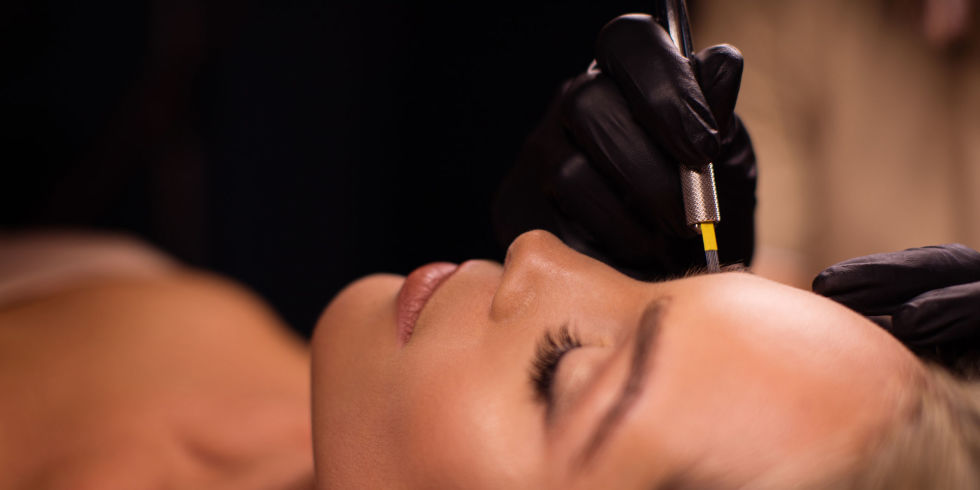Ask the average woman if she’d like to get a tattoo on her face and she’ll probably call you crazy. Ask her if she’d like to have perfectly shaped eyebrows that don’t require any makeup, however, and she’ll probably ask how.
The answer: by getting a tattoo on her face.
Sort of.
Microblading is definitely not the eyebrow tattoos of yesteryear — remember when people would shave off their brow hair and tattoo unnatural-looking lines back on? The cosmetic technique that has become increasingly popular in the last couple of years. It promises bolder brows with a natural appearance ts a small, handheld tool topped off with microneedles, which deposit pigment under the first layer of skin via strokes that resemble brow hairs.
The procedure is all over Instagram, and the results can be incredibly flattering, realistic and downright face-changing. If you’re not quite sure microblading is the solution to your brow complaints, here’s what you need to know before making your decision.
Unlike traditional tattoos, microblading is not permanent.
Microblading is semipermanent, meaning it lasts anywhere from six to 36 months, depending on who you ask. “After the initial treatment, a touch-up or ‘perfection session’ is needed within four to eight weeks, then every six to 12 months,” says Kler Rosenberg, head trainer at Microblading Academy USA and owner of Brow & Beauty Bar in Boca Raton, Florida.
Microblading is not for everyone.
“The perfect candidate for microblading is someone who wants to fully reconstruct, define, cover gaps or fill in over-plucked brows,” explains Skyy Hadley, founder of Blink Beauty Boutique, which has locations in New Jersey and New York City. “Those who just want to add a slight arch are also great candidates.”
However, certain skin and medical conditions may make you a less-than-ideal candidate, including oily skin, eczema, psoriasis, rosacea, dermatitis, pregnancy and some autoimmune disorders. Furthermore, “sensitive skin types will bleed easily resulting in poor retention of the pigment and a less than desirable result in microblading,” Hadley says.
Microblading shouldn’t be performed by just anyone.
“Look for qualified technicians who are certified by either the American Academy of Micropigmentation (AAM) or the Society of Permanent Cosmetic Professionals (SPCP),” Hadley advises. “These professionals are required to have years of experience and pass a board- or industry-approved exam to obtain their instructor certification.”
It may or may not hurt.
Many microblading professionals will apply a topical anesthetic to make their clients more comfortable — there are needles involved, after all.
“Once the skin is open, the anesthetic works immediately and you won’t feel any pain,” Rosenberg says.
In fact, some clients think the experience is relatively painless even without the use of an anesthetic.
“Based on what I’d heard, I prepared myself for horrible pain and a really disturbing scraping sound, but it was 100% bearable — though yes, uncomfortable,” says Stephanie Shore Fisher, GoodHousekeeping.com’s senior social and video editor, who received her microblading treatment from Nicoleta Palmer, co-founder of Brow Philosophy in Beverly Hills. “And I didn’t hear any sound at all.”
The results are instant — and a little intense.
While any change to your eyebrows can require an adjustment period, don’t be alarmed if they look especially bold at first.
“Immediately following your procedure, the tattooed area will appear to be darker and bolder in color, more sharply defined or even have a more filled in appearance,” Hadley explains. Worry not — this isn’t your final look.
“They fade in about a week or two,” Rosenberg assures.
You’re responsible for proper aftercare.
In order to achieve the best results, your practitioner will give you instructions on what to do and not do during the first few days after your microblading appointment. Some may recommend washing your brows and applying ointment while others will tell you to do the exact opposite. The important thing is to listen to your trusted pro.
Some wise advice across the board: “I would recommend no heavy sweating for four days and stay out of direct sunlight,” Hadley says.













